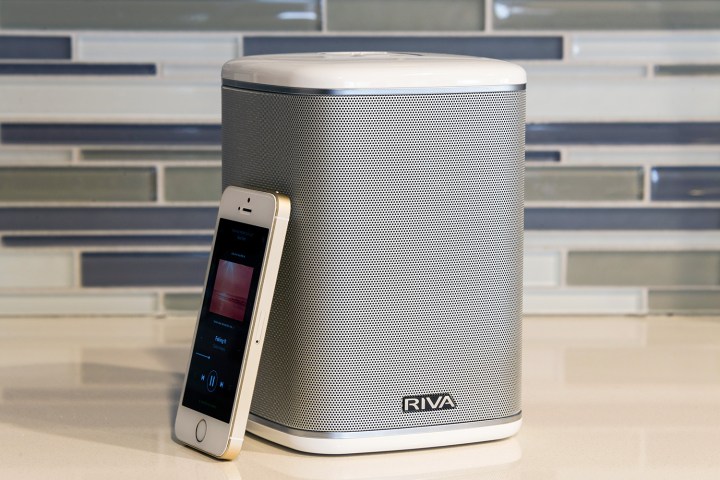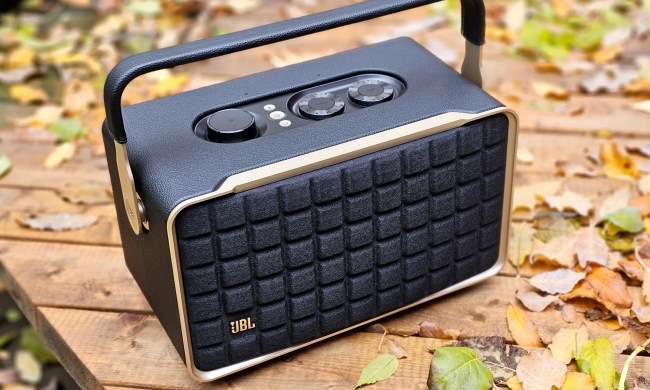“The Riva Arena is the best combination of fidelity and usability we have ever seen in a speaker its size.”
- Elegant, compact design
- Multiple ways to connect
- Clear, room-filling sound
- Easy to use on iOS or Android
- Portable option available
- Short power cable
When Riva Audio announced its first foray into multiroom audio, the two-speaker lineup it calls the Wand series, our interest was understandably piqued. The young company’s excellent Turbo X was our favorite portable speaker of 2016, impressing with a beautiful sound signature in a small and versatile package. As such, reviewing the larger Riva Festival and the smaller Arena speakers was a no-brainer.
At first glance, the Arena looks like a shot aimed straight at Sonos’ bow, sporting an eerily similar design to the Sonos Play:1, but begging a slightly increased price point and a few extra features as well. After spending time with the Arena, both in the office and at home, we discovered those extra bells and whistles make it much more than a glitzed-up Play:1 clone. Not only does this mini multiroom tower offer room-filling stereophonic audio and shockingly loud volume for its size, it also tacks on Bluetooth, splash-proofing, and an optional 20-hour battery. Those features combine with excellent fidelity to place the Arena among the best pint-sized speakers we’ve tested — multiroom or otherwise.
Out of the Box
Thanks to the Arena sound system’s all-in-one design, there’s not much to the unboxing experience. Inside a small silver package you’ll find three basic ingredients: The device, a power cable, and an instruction manual for setup and operation.
Features and Design
The Arena has rounded edges and a stout posture that make it look a bit like a rectangular marshmallow, especially the white-and-silver model (the Arena is also available in a more muted black-and-charcoal exterior). It’s easy to see why the speaker is considered a direct stab at the Sonos Play:1. Each of the speakers are weighty and compact, with rounded grilles that extend around their entire mid-section, and each speaker easily disappears on a bookshelf or corner table. The Riva is a bit larger than the Play:1 overall, but its sleek looks will still appeal to those who take the their living space’s minimalist aesthetic seriously.
The top of the Arena features four buttons for volume control and song skip, arranged in a rectangle around a central play/pause button with an LED ring around it. Large labels make it easy to discern the function of each button. Bluetooth pairing is done by holding the skip-back button for three seconds, while holding skip forward for three seconds changes the input. The LED ring around the central play/pause button changes colors to indicate source, a clever feature indicating the speaker’s intuitive design.
Around the back of the Arena you’ll find a ¼-inch threaded insert for mounting, a USB port for charging mobile devices, a 3.5 mm audio input, and a switch that puts the Arena in Away Mode — a special mode that allows you to connect two or more Wand speakers together without a home Wi-Fi network for an multiroom setup.
Riva’s sleek looks will appeal to those who take the their living space’s minimalist aesthetic seriously.
One way in which the Arena differentiates itself from competitors is its many wireless playback options, offering an astonishing array of inputs to choose from. For Wi-Fi streaming, the speaker features Google’s Chromecast and Apple’s AirPlay built-in, as well as support for Spotify Connect and DNLA connectivity. Adding in Bluetooth and 3.5 mm inputs makes the Wand speakers among the most versatile all-in-one multiroom speaker systems we’ve tested. In addition, the speakers play nicely with just about any interface — from Windows 10 and Android to OSX and iOS – almost instantly.
The speaker features three custom-built ADX drivers and three passive radiators positioned in the front, left, and right positions, combined with Riva’s Trillium Audio digital signal processing (DSP) technology for a wide soundstage.
For those who plan on taking the Arena on the go – from camping trips to all-day barbecues — Riva offers an attachable 20-hour battery pack. At $100, the pack does cost a pretty penny, but it’s absolutely worth considering for those on the move; even at that price, the speaker easily competes with the highest-end Bluetooth speakers in terms of audio quality (more on that below). Unlike many multiroom speakers, the Arena is also splash resistant, making poolside listening less nerve-racking.
Setup
Setting up the Riva Arena for Bluetooth or Wi-Fi is simple and intuitive. Once the speaker is turned on for the first time, it will automatically go into setup mode. Regardless of whether you’re using iOS or Android, the Riva Wand app will guide you through an easy process to connect to your home network, after which the speaker is ready to stream via AirPlay, Spotify Connect, or Google Home.
Once all your speakers are connected it’s easy to group speakers or stream audio to each individually over Chromecast or Airplay. We particularly liked the way that Spotify Connect integrated with our Moto X Pure Edition phone, allowing us to choose where to direct audio without ever leaving the Spotify app.
Multiroom performance
We tested the Riva Arena both in our A/V testing room and at home over the course of several weeks. At home, the Arena was placed on a kitchen counter, with a larger Riva Festival placed about 30 feet away in the living room. We listened to both speakers together and separately throughout the testing period, just like you probably will at home.
We rarely encounter devices as pleasant to use as the Riva Wand series speakers. Anyone connected to our home and office Wi-Fi networks could almost instantly play whatever audio they wanted wherever they wanted, regardless of whether they had an iOS or Android device. In fact, the five roommates in our large Portland household found themselves listening to music a lot more often in general because it was so easy to just reach for their phones and rock out, which definitely elevated the fun factor in common areas during our review period.
Pairing the speakers in Away Mode was also quick and painless via the included instructions, and makes it easy to take multiple Wand series speakers anywhere for a full multiroom experience with or without Wi-Fi. Sure, Away Mode isn’t a feature that many will use often, but it is nice to have the option for the occasional outdoor party or camping trip, and it’s something most competitors just don’t offer.
Audio Performance
As foreshadowed above, the fidelity offered by the Riva Arena is impressive, especially when considering its diminutive size. The speaker’s array of drivers in three positions translates to a very dynamic and open soundstage, pushing audio to all corners of small and even medium-sized rooms.
The stereo imaging offered by the Arena is downright incredible for a single speaker this size. When listening to classic stereo mixes like Fleetwood Mac’s The Chain, the dramatically hard-panned acoustic guitars were audible far off to the right, with the bass lines holding things together in the very middle of the sound.
The stereo imaging offered by the Arena is downright incredible for a single speaker this size.
Despite its tiny footprint, the Arena’s sound signature actually leans on the heavy side in terms of frequency response, offering deep but not overly boom-y bass on songs like Run The Jewels’ Oh My Darling Don’t Cry. The mid and high registers, though somewhat restrained when compared to the surprising low and low-mid response, are well balanced in the mix, providing just the right amount of shimmer in the cymbals on jazz mixes like Dafnis Prieto’s About The Monks.
In fact, the stellar imaging and well-balanced sound profile really made jazz a go-to genre when we were listening to the Arena, with everything from Thad Jones and Mel Lewis’ big band to Miles Davis’ psyched-out fusion tracks sounding vibrant, fun, and dynamic.
When compared to Sonos multiroom speakers like the Play:1 and Play:5, the Wand series speakers sound noticeably warmer and offer broader stereo imaging. When playing the Arena side-by-side with the Sonos Play:1, the former offered a significantly wider soundstage (understandable seeing as the Play: 1 is a mono speaker), and a boosted lower-midrange. When sitting directly in front of each speaker we preferred the crisper upper register of the Sonos, but the much wider stereo image of the Riva Arena was vastly preferable when moving around a room — as we often were when the speaker was placed in a kitchen for at-home testing. Given that both are meant to fill small rooms with sound, rather than provide a true sit-and-listen experience, we preferred the Riva.
Warranty information
Every Riva product features the same two-year limited warranty that guards against manufacturer defects.
Our Take
The Riva Arena is an excellent-sounding and easy to use multiroom speaker that can tackle just about any kind of audio you throw at it, easily ranking among the best small-footprint speakers we have ever tested.
Is there a better alternative?
Those after an accessible multiroom speaker for small and medium sized rooms will likely want to consider the Sonos Play:1, which is still a solid competitor by any metric. Though the Sonos doesn’t offer Bluetooth streaming, it is compatible with Amazon’s Alexa and can be used as part of a surround speaker system including Sonos’ PlayBar or PlayBase speakers, as well as combined with a Sonos Sub subwoofer. On the flip side, JLab’s $150 Block Party is a much more affordable alternative for on-the-go multiroom listening, as long as you don’t mind giving up the option of Wi-Fi connection.
How long will it last?
The overall build quality of the Riva Arena is very high, and the many input options and water resistance mean it should last for many years of use.
Should you buy it?
Yes. The Riva Arena is the best combination of fidelity and usability we have ever seen in a speaker its size, making it absolutely worth every penny.










